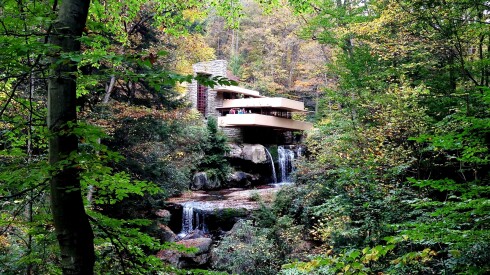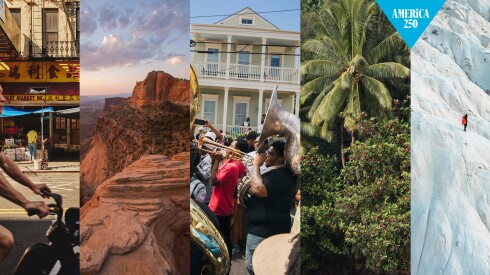Best of Yellowstone
Yellowstone National Park packs more natural wonder within its boundaries—more waterfalls and geysers, more grizzlies and bison, more mountains and canyons—than most visitors can witness. Hot tip: Walk a half-mile off the well-traveled highway and get the park to yourself.
Mt Washburn, Wyoming 82190, USA
Hike three miles and 1,393 feet up an old stagecoach/wagon road from the top of Dunraven Pass to the 10,243-foot summit of Mount Washburn. Along the way, you’ll see wildflowers—more than 50 species bloom on the mountain—marmots, picas, gnarled whitebark pines, and, possibly, bears. At the top, there are 360-degree views that include Jackson Lake, the Teton Range, and the Grand Canyon of the Yellowstone. The park’s main fire lookout is also on Mount Washburn’s summit. The two-story building and the multiple antennae exploding from its roof are unsightly, but inside its base are worthy interpretive exhibits. Cyclists aren’t allowed on the Dunraven Trail, but they can ride up Mount Washburn from a trailhead on Chittenden Road, several miles past Dunraven Pass. Also a former stagecoach road, this route up the mountain ascends 1,500 feet over 2.5 miles.
Grand Canyon of the Yellowstone, Wyoming 82190, USA
See proof that the idea behind national parks—preserving spectacular landscapes—has been successful at the Grand Canyon of the Yellowstone. In 1871, William Henry Jackson took more than 100 photos with an 8x10 plate camera. (His photos were a large part of why Yellowstone was, in 1872, named the world’s first national park.) Jackson took several shots of various places in the 24-mile long Grand Canyon of the Yellowstone, including of the Upper and Lower Falls. In 2017, Jackson-based photojournalist Bradly J. Boner published the book, Yellowstone National Park: Through the Lens of Time, in which he rephotographed all but one of Jackson’s images. The book shows Boner’s modern-day photos side-by-side with Jackson’s. It turns out the Grand Canyon of the Yellowstone is very little changed.
Upper Geyser Basin, Wyoming 82190, USA
Half of the world’s geysers are in Yellowstone. There’s Old Faithful, the most famous geyser in the world, but you’ll also find more than 500 others. Check out Old Faithful—and pop into the visitor center for a multimedia lesson on geysers—and then head out along the boardwalk trails to see some of the park’s less-crowded spouters. Riverside Geyser, a cone geyser on the bank of the Firehole River in the Upper Geyser Basin, erupts for 20 minutes every 5.5 to 6.5 hours, shooting a 75-foot stream of boiling water across the river. On sunny days, you can spot a rainbow in its mist. Also in the Upper Geyser Basin, the tallest predictable geyser in the world, called Grand Geyser, erupts every seven to 15 hours, shooting water as high as 200 feet.
602 N 4700 E, Ashton, ID 83420, USA
Since the first abandoned rail corridors were turned into trails in the 1960s, more than 15,000 miles of rail trails have been constructed in the U.S. The 30 miles of rail trail between Tetonia and Ashton, Idaho, on the western side of the Tetons south of Yellowstone, might be among the country’s most scenic. Because it’s Idaho, there are potato fields almost as far as the eye can see, as well as wheat fields and stands of aspen trees. But it’s the Tetons looming in the distance—their snaggly profile easily recognizable even in reverse (most images of the range are taken from its eastern face)—that grab your attention. The three beautiful and historic trestle bridges the route crosses are just showing off. Stop in Ashton at the classic Frostop Drive-In for a malted shake and burger.
Only about 100,000 people visit Yellowstone during winter. Overnight stays are limited to some seasonal lodging options at Mammoth Hot Springs and Old Faithful. But there’s another choice for a special kind of traveler: Sign on with Yellowstone Expeditions to stay at their yurt camp, located a half mile from the rim of the park’s Grand Canyon, and you’ll feel like you have Yellowstone all to yourself. “Rooms” here are private, double-occupancy heated cabins, and four-, five-, and eight-day trips are available. The camp also offers a cedar sauna, and breakfast, lunch, and dinner prepared daily and served around a wood-burning stove in a yurt. The main activities? Wildlife watching, cross-country skiing, and snowshoeing.
163 Chico Rd, Pray, MT 59065, USA
With only a couple of exceptions, you can’t soak in Yellowstone’s thermal features (this is for numerous reasons, not the least of which is that most are so scalding hot they’d burn the flesh off you). North of Gardiner, Montana, though, in the no-stoplight community of Pray, Chico Hot Springs has welcomed soakers to its spring-fed hot pools since 1900. Spend the night in one of the quirky rooms in the historic main lodge, originally built as a boardinghouse for miners, or in a refurbished caboose from the Northern Pacific Railroad. If at all possible, plan to be at Chico on a Sunday morning, when it serves the best brunch in Montana.
When the Art family bought the struggling Chico Hot Springs Resort in 1972, some of the earliest improvements they made were to its dining room. The idea was to create one of the best restaurants in the state; if guests came for the food, maybe they’d spend the night. The family succeeded. Today the Chico Dining Room is so beloved it spawned a cookbook, A Montana Table: Recipes from Chico Hot Springs Resort. While ingredients are as fresh as can be—with produce from on-site greenhouses, meat from local ranchers, seafood flown in overnight from the coast—the menu includes some dishes that have been around for more than 40 years. The classic Chico meal is beef Wellington (service for two) and, for dessert, a Flaming Orange, which is exactly what it sounds like.
When the Art family bought the struggling Chico Hot Springs Resort in 1972, some of the earliest improvements they made were to its dining room. The idea was to create one of the best restaurants in the state; if guests came for the food, maybe they’d spend the night. The family succeeded. Today the Chico Dining Room is so beloved it spawned a cookbook, A Montana Table: Recipes from Chico Hot Springs Resort. While ingredients are as fresh as can be—with produce from on-site greenhouses, meat from local ranchers, seafood flown in overnight from the coast—the menu includes some dishes that have been around for more than 40 years. The classic Chico meal is beef Wellington (service for two) and, for dessert, a Flaming Orange, which is exactly what it sounds like.















